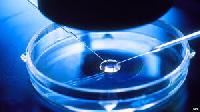
Intracytoplasmic Sperm Injection
ICSI stands for Intracytoplasmic Sperm Injection. The procedure is a specialized form of in vitro fertilization in which a single sperm is directly injected into a mature egg. It is used to help the patients who have very low sperm count or poor sperm quality. One or two of the resulting embryos can be transferred to your womb in the same way as in a conventional IVF cycle.
...more
Surrogacy
Surrogacy is the process in which the mother and father’s genetic material is placed in another woman’s womb (surrogate) who carries and gives birth therefore essentially it is their baby, genetically and is nurtured by the surrogate’s womb who handover the baby to the rightful parents.
...more
ivf treatment
In vitro Fertilization (IVF) literally means fertilization in glass. IVF is used for the treatment of male and female infertility. Originally, it is called a ‘test-tube’ technique in which the process of mixing of eggs and sperm takes place outside the body. IVF is the basis of most fertility treatments.
...more
Intrauterine insemination services
Intrauterine insemination (IUI) or artificial insemination is a simple fertility treatment procedure in which small amount of prepared sperm (washed sperm) is directly implanted into the woman’s uterus so that fertilization of an egg can occur. Though IVF (in vitro fertilization) treatment is often the most advanced option of achieving a pregnancy, in some circumstances, our doctors suggest a simpler, less invasive method.
...more
fertility treatments
For fertility treatments, egg donation has now become an essential part. Since the time it was introduced, many couples have overcome the infertility issues and have a successful pregnancy and childbirth. In the infertile situations, the couple can opt for donated eggs by which they can become pregnant without any risk involved. Mostly, the chances of pregnancy are higher than the IVF treatment, if the couple opts for the donated eggs. It is because the donors tend to be younger and more fertile than the women who are seeking IVF treatment. The procedure starts with the selection of the donor. The donor once selected, undergoes psychological, medical and genetic screenings so as to confirm that the donor is an acceptable candidate.
...more
Infertility Workup
Before initiating an IVF cycle, it is critical for a patient to go for a preliminary investigation that will undertake hisher previous medical history and a number of tests commonly known as IVF pre-screening tests. Your doctor will determine which tests need to performed before initiating a cycle.
...more
Hysteroscopy Treatment
Hysteroscopy is a procedure that allows your doctor to look inside your uterus in order to diagnose and treat causes of abnormal bleeding. The procedure is done using a hysteroscope, a thin, lighted tube that is inserted into the vagina to examine the cervix and inside of the uterus. It also involves the insertion of an endoscope to produce images of the inside of the uterus which can be used for the future reference. Hysteroscopy can be either diagnostic or operative
...more
Blastocyst Transfer Services
During the IVF programme, on the second or the third day the embryos are transferred following the egg retrieval at the four to eight cell stages. For two or three more days, the IVF embryos must continue to grow so that it reaches the blastocyst transfer stage (50-150 cells) before they are ready for the implantation into the endometrium or the uterine wall. Recent advances in IVF laboratory treatments have allowed for the successful culture of embryos to the blastocyst stage.
...more
laparoscopy
Laparoscopy is also known as minimally invasive surgery and is a modern surgery technique in which the operations in the abdomen are performed through tiny incisions which are usually of 0.5 to 1.5 cm as opposed to the larger incisions needed in laprotomy.
...more
Cryopreservation
Cryopreservation is a technique where sperms, oocytes or embryos are preserved for future use. During the procedure, the lab will freeze sperm by cooling to low sub zero temperatures, such as -196 degrees C. In other words, cryopreservation is used in infertility programs to freeze and store sperm, eggs or to freeze “leftover” embryos from an in vitro fertilization cycle. The two methods that are currently used for freezing in IVF labs: Slow freezing and vitrification.
...more
Preimplantation Genetic Diagnosis
Preimplantation genetic diagnosis (PGD) is an early form of prenatal diagnosis, in which embryos created in vitro are analyzed to help identify genetic defects and to prevent certain diseases or disorders from being passed on to the child. Thus, PGD is an addition to assisted reproductive technology, and requires in vitro fertilization (IVF) to obtain oocytes or embryos for evaluation.
...more
Percutaneous Epididymal Sperm Aspiration
PESA is a simple technique to obtain sperm for Intracytoplasmic Sperm Injection (ICSI) in men who have an obstruction of the vas deferens, either due to vasectomy or other obstruction. The procedure involves a small needle that is inserted through the skin of the scrotum to collect sperm from the epididymis, where sperm are usually stored after production in the testes. In 80% of attempts, sufficient sperm for ICSI is obtained while in 10% of cases enough suitable sperm is found for cryopreservation. The procedure is performed with local anesthesia and is coordinated with the female partner’s egg retrieval.
...moreBe first to Rate
Rate ThisOpening Hours